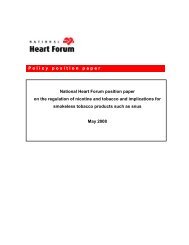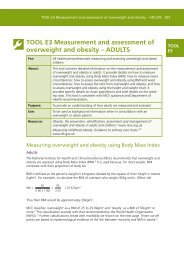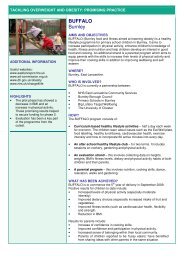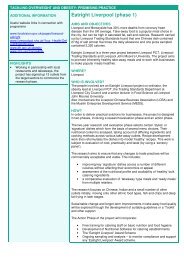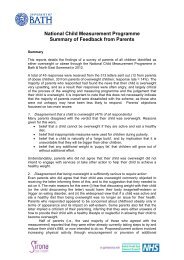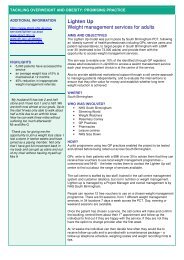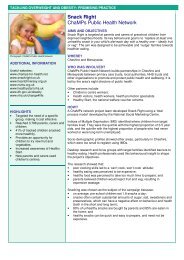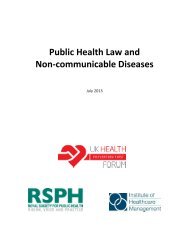The Challenge of Non-Communicable Diseases and Road Traffic ...
The Challenge of Non-Communicable Diseases and Road Traffic ...
The Challenge of Non-Communicable Diseases and Road Traffic ...
Create successful ePaper yourself
Turn your PDF publications into a flip-book with our unique Google optimized e-Paper software.
4 <strong>The</strong> <strong>Challenge</strong> <strong>of</strong> <strong>Non</strong>-communicable <strong>Diseases</strong> <strong>and</strong> <strong>Road</strong> <strong>Traffic</strong> Injuries in Sub-Saharan Africa<br />
mentable at little additional cost, which focus on<br />
prevention <strong>of</strong> common modifiable risk factors. <strong>The</strong>y<br />
include proven measures to reduce tobacco <strong>and</strong> alcohol<br />
use, such as increased taxation; a ban on advertising,<br />
promotion <strong>and</strong> sponsorship; protection<br />
from exposure to tobacco smoke; <strong>and</strong> drink-driving<br />
counter-measures. As overweight/obesity emerges<br />
as an issue, measures are also being put in place to<br />
regulate other ‘unhealthy commodities’ such as ultra-processed,<br />
energy-dense, nutrition-poor food<br />
<strong>and</strong> drink. To prevent RTIs, law-enforcement needs<br />
to be combined with public awareness campaigns<br />
<strong>and</strong> education to increase seatbelt use <strong>and</strong> helmet<br />
wearing, <strong>and</strong> to reduce speeding <strong>and</strong> drink-driving.<br />
Legislation <strong>and</strong> regulation can also protect against<br />
some occupational <strong>and</strong> environmental hazards such<br />
as outdoor air pollution, industrial waste <strong>and</strong> contamination<br />
<strong>of</strong> drinking water <strong>and</strong> soil, which can exacerbate<br />
asthma or be linked to carcinogenic agents.<br />
It should be noted that policy makers need to avoid<br />
the potential negative consequences that some population-based<br />
actions might create. For example, it<br />
is important to ensure that measures to alleviate under-nutrition<br />
do not have deleterious consequences<br />
for over-nutrition. And while developing a healthsupporting<br />
environment that facilitates walking <strong>and</strong><br />
cycling can be part <strong>of</strong> a pro-growth <strong>and</strong> pro-poor<br />
transport strategy, such an environment should also<br />
be safe <strong>and</strong> protect vulnerable road users.<br />
(iii) Promote ‘treatment as prevention’, <strong>and</strong><br />
effective care<br />
Health services can implement a number <strong>of</strong> proven,<br />
targeted preventive measures – at relatively low<br />
cost – for CVD, diabetes, chronic respiratory diseases<br />
<strong>and</strong> cancer, <strong>and</strong> acute <strong>and</strong> chronic conditions.<br />
<strong>The</strong>se measures include multidrug treatment for individuals<br />
at high risk <strong>of</strong> a cardiovascular event; drug<br />
treatment <strong>of</strong> myocardial infarction; glycemic control<br />
<strong>and</strong> foot care for people with diabetes; <strong>and</strong> several<br />
highly cost-effective interventions to combat cancer,<br />
such as Hepatitis B vaccination for liver cancer prevention,<br />
HPV vaccination for cervical cancer control,<br />
<strong>and</strong> male circumcision to reduce high-risk HPV.<br />
Prompt emergency care for RTIs <strong>and</strong> acute NCD<br />
events can save lives, reduce the incidence <strong>of</strong> shortterm<br />
disability <strong>and</strong> dramatically improve long-term<br />
consequences for patients <strong>and</strong> their families. At the<br />
same time, screening programs, for example for<br />
cancer, can raise awareness <strong>of</strong> early signs <strong>and</strong> symptoms<br />
<strong>of</strong> those cancers amenable to early diagnosis,<br />
<strong>and</strong> increase the quality <strong>and</strong> coverage <strong>of</strong> effective<br />
evidence-based treatment using st<strong>and</strong>ardized protocols<br />
– thus can increasing survival rates. Where facilities<br />
are limited, non-laboratory tools are needed<br />
to support such screening <strong>and</strong> assess risk cheaply<br />
<strong>and</strong> quickly. Where the majority <strong>of</strong> cancer is diagnosed<br />
late, improvement in quality <strong>of</strong> life can be<br />
achieved relatively inexpensively by improving access<br />
to pain management <strong>and</strong> supportive care close<br />
to home – palliative <strong>and</strong> home-based care programs<br />
already in place for HIV/AIDS are transferrable to<br />
other conditions.<br />
(iv) Adapt <strong>and</strong> strengthen health systems<br />
Together with other disease groups, NCDs <strong>and</strong> RTIs<br />
face constraints across all main components <strong>of</strong> a<br />
health system, but solutions can be shared across<br />
programs <strong>and</strong> initiatives, <strong>and</strong> be part <strong>of</strong> a wider systemic<br />
improvement.<br />
Common problems faced by disease groups include<br />
the heavy reliance on external financing <strong>and</strong><br />
the shortfall in total health expenditure per capita.<br />
Health-care infrastructure is insufficient across all<br />
tiers <strong>of</strong> service delivery – not just facilities but also<br />
laboratory <strong>and</strong> diagnostic systems <strong>and</strong> capabilities<br />
– while primary care is limited in many places.<br />
<strong>The</strong> severe shortage <strong>and</strong> imbalanced distribution <strong>of</strong><br />
trained health workers is not just an obstacle to tackling<br />
NCDs but also to the delivery <strong>of</strong> good quality<br />
clinical services in general, jeopardizing achievement<br />
<strong>of</strong> the MDGs <strong>and</strong> improvement <strong>of</strong> the overall<br />
health <strong>of</strong> the poor. Moreover, all the main health <strong>and</strong><br />
disease programs draw from the same data sources<br />
<strong>and</strong> share common challenges <strong>of</strong> weak information<br />
systems, limited civil registration, <strong>and</strong> unreliable vital<br />
statistics – which make it difficult to assess disease<br />
burden <strong>and</strong> create a compelling political case<br />
for action.<br />
<strong>The</strong> chronic, life-long nature <strong>of</strong> many NCDs<br />
heightens some <strong>of</strong> these issues. <strong>The</strong> limited financial<br />
<strong>and</strong> social protection against the high costs <strong>of</strong><br />
health-care can mean that a life-long condition or



